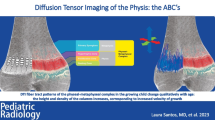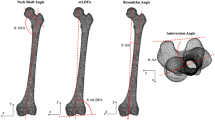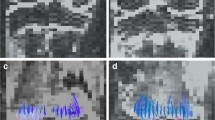Abstract
Background
Diffusion-tensor imaging (DTI) depicts the movement of water through columns of cartilage and newly formed bone and provides information about velocity of growth and growth potential.
Objective
To determine the correlation between DTI tractography parameters of the distal femoral physis and metaphysis and the height change after DTI in pubertal and post-pubertal children.
Materials and methods
We retrospectively analyzed DTI images of the knee in 47 children with a mean age of 14.1 years in a 2-year period. In sagittal echoplanar DTI studies, regions of interest were placed in the femoral physis. Tractography was performed using a fractional anisotropy threshold of 0.15 and a maximum turning angle of 40°. The sample was divided to assess short-term and long-term growth after DTI. Short-term growth (n=25) was the height change between height at MRI and 1 year later. Long-term growth (n=36) was the height gain between height at MRI and at the growth plateau.
Results
For the short-term group, subjects with larger tract volume (R2=0.40) and longer track lengths (R2=0.38) had larger height gains (P<0.01). For the long-term group, subjects with larger tract volume (R2=0.43) and longer track lengths (R2=0.32) had a larger height gain at the growth plateau (P<0.01). Intra- and inter-observer variability were good–excellent.
Conclusion
Follow-up data of growth 1 year after DTI evaluation and at skeletal maturity confirms that DTI parameters are associated with the amount of post-imaging growth.




Similar content being viewed by others
References
Pfaffle R (2015) Hormone replacement therapy in children: the use of growth hormone and IGF-I. Best Pract Res Clin Endocrinol Metab 29:339–352
Gerstenfeld LC, Shapiro FD (1996) Expression of bone-specific genes by hypertrophic chondrocytes: implication of the complex functions of the hypertrophic chondrocyte during endochondral bone development. J Cell Biochem 62:1–9
Villemure I, Stokes IA (2009) Growth plate mechanics and mechanobiology. A survey of present understanding. J Biomech 42:1793–1803
Wilsman NJ, Farnum CE, Green EM et al (1996) Cell cycle analysis of proliferative zone chondrocytes in growth plates elongating at different rates. J Orthop Res 14:562–572
Cohen P, Rogol AD, Deal CL et al (2008) Consensus statement on the diagnosis and treatment of children with idiopathic short stature: a summary of the Growth Hormone Research Society, the Lawson Wilkins Pediatric Endocrine Society, and the European Society for Paediatric Endocrinology workshop. J Clin Endocrinol Metab 93:4210–4217
Bayley N, Pinneau SR (1952) Tables for predicting adult height from skeletal age: revised for use with the Greulich-Pyle hand standards. J Pediatr 40:423–441
Jaimes C, Berman JI, Delgado J et al (2014) Diffusion-tensor imaging of the growing ends of long bones: pilot demonstration of columnar structure in the physes and metaphyses of the knee. Radiology 273:491–501
Wang N, Mirando AJ, Cofer G et al (2019) Diffusion tractography of the rat knee at microscopic resolution. Magn Reson Med 81:3775–3786
Bedoya MA, Delgado J, Berman JI et al (2017) Diffusion-tensor imaging of the physes: a possible biomarker for skeletal growth-experience with 151 children. Radiology 284:210–218
Kelly A, Winer KK, Kalkwarf H et al (2014) Age-based reference ranges for annual height velocity in US children. J Clin Endocrinol Metab 99:2104–2112
Soliman A, De Sanctis V, Elalaily R et al (2014) Advances in pubertal growth and factors influencing it: can we increase pubertal growth? Indian J Endocrinol Metab 18:S53–S62
Kuczmarski RJ, Ogden CL, Guo SS et al (2002) 2000 CDC growth charts for the United States: methods and development. Vital Health Stat 11:1–190
Wang R, Benner T, Sorensen A et al (2007) Diffusion toolkit: a software package for diffusion imaging data processing and tractography [abstr]. In: Proceedings of the fifteenth meeting of the International Society for Magnetic Resonance in medicine. International Society for Magnetic Resonance in Medicine, Berkeley
Koo TK, Li MY (2016) A guideline of selecting and reporting intraclass correlation coefficients for reliability research. J Chiropr Med 15:155–163
Seinsheimer F 3rd, Sledge CB (1981) Parameters of longitudinal growth rate in rabbit epiphyseal growth plates. J Bone Joint Surg Am 63:627–630
Buckwalter JA, Mower D, Ungar R et al (1986) Morphometric analysis of chondrocyte hypertrophy. J Bone Joint Surg Am 68:243–255
Farnum CE, Lee R, O'Hara K et al (2002) Volume increase in growth plate chondrocytes during hypertrophy: the contribution of organic osmolytes. Bone 30:574–581
Yun HH, Kim HJ, Jeong MS et al (2018) Changes of the growth plate in children: 3-dimensional magnetic resonance imaging analysis. Korean J Pediatr 61:226–230
Huntley JS, Bush PG, Hall AC et al (2003) Looking at the living human growth plate. CMAJ 168:459–460
Harcke HT, Mandell GA (1993) Scintigraphic evaluation of the growth plate. Semin Nucl Med 23:266–273
Tanner JM, Whitehouse RH, Takaishi M (1966) Standards from birth to maturity for height, weight, height velocity, and weight velocity: British children, 1965. I. Arch Dis Child 41:454–471
Author information
Authors and Affiliations
Corresponding author
Ethics declarations
Conflicts of interest
Jeffrey I. Berman works as a consultant for McGowan Associates.
Additional information
Publisher’s note
Springer Nature remains neutral with regard to jurisdictional claims in published maps and institutional affiliations.
Rights and permissions
About this article
Cite this article
Barrera, C.A., Bedoya, M.A., Delgado, J. et al. Correlation between diffusion tensor imaging parameters of the distal femoral physis and adjacent metaphysis, and subsequent adolescent growth. Pediatr Radiol 49, 1192–1200 (2019). https://doi.org/10.1007/s00247-019-04443-z
Received:
Revised:
Accepted:
Published:
Issue Date:
DOI: https://doi.org/10.1007/s00247-019-04443-z




